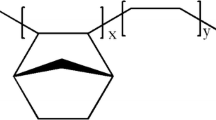Abstract
Chain-extension reactions were carried out using titanium-iso-propoxide (TIP) as a catalyst for a series of polyesters or copolyesterethers with low molecular weights (M n =1500–10,000) synthesized by the ring-opening copolymerization of succinic anhydride (SA) with ethylene oxide (EO). The copolymers having aM n from 25,000 to 50,000 of different properties were obtained. Both the melting point (T m ) and the fusion heat (δH), which indicate the crystallinity of the copolymers, rose with an increase in SA content in the copolymers. Semitransparent films were prepared by compression molding of the copolymers. The biodegradation of the copolymer films was evaluated by enzymatic hydrolysis by lipases and by an aerobic gas evolution test in standard activated sludge. The hydrolyzability of these copolymers by three kinds of lipases was affected by their copolymer composition SA/EO, form, andM n . The copolyesterether (SA/EO=43/57,M n =48,900) was more easily biodegraded by standard activated sludge compared to the polyester (SA/EO=47/53,M n =36,300).
Similar content being viewed by others
References
M. S. Reeveet al. (1994)Macromolecules,27 825–831.
A. M. Reed and D. K. Gilding (1981)Polymer 22 494–507.
M. Yoshidaet al. (1990)Eur. Polym. J. 26 121–130.
H. R. Kricheldorfet al. (1984)Macromolecules 17 2173–2181.
Y. Tokiwaet al. (1979)J. Appl. Polym. Sci. 24 1701–1711.
A. Nakayamaet al. (1995)Polymer 36 1295–1301.
D. Goldberg (1995)J. Environ. Polym. Degrad. 3 61–68
H. Fukuzakiet al. (1988)Eur. Polym. J. 24 1029–1036.
D. K. Song and Y. K. Sung (1995)J. Appl. Polym. Sci. 56 1381–1387.
Y. Kimuraet al. (1989)Polymer 30 1342–1349.
Y. Tokiwa and S. Komatsu (1994)Polym. Prep. Jpn. 43 4042–4043.
M. Taniguchiet al. (1993)Prep. Jpn. 42(9), 3878–3788.
E. Takiyama and T. Fujimaki (1994) in Y. Doi and K. Fukuda (Eds.),Biodegradable Plastics and Polymers, Elsevier Science, Amsterdam, Vol.12, pp. 150–174.
Y. Maedaet al. (1993)Kobunshi Ronbunshu 50 723–729.
Y. Maedaet al. (1994)Kobunshi Ronbunshu 51 724–730.
Y. Maedaet al. (1994)Kobunshi Ronbunshu 51 771–777.
Y. Maedaet al., manuscript in preparation.
A. Hamitouet al. (1979)J. Polym. Sci. Polym. Chem. Ed. 15 865–873.
Y. Tokiwaet al. (1979)J. Appl. Polym. Sci. 24 1701–1711.
A. Nakayamaet al. (1993)Polym. Preprints Japan 42 3739–3740.
Author information
Authors and Affiliations
Rights and permissions
About this article
Cite this article
Maeda, Y., Nakayama, A., Kawasaki, N. et al. Properties and biodegradability of chain-extended copoly(succinic anhydride/ethylene oxide). J Environ Polym Degr 4, 225–233 (1996). https://doi.org/10.1007/BF02070691
Issue Date:
DOI: https://doi.org/10.1007/BF02070691




